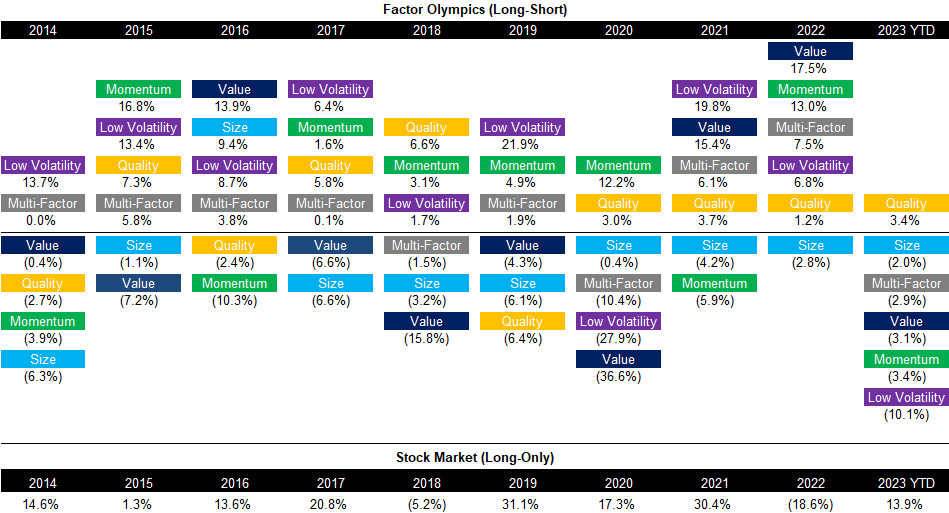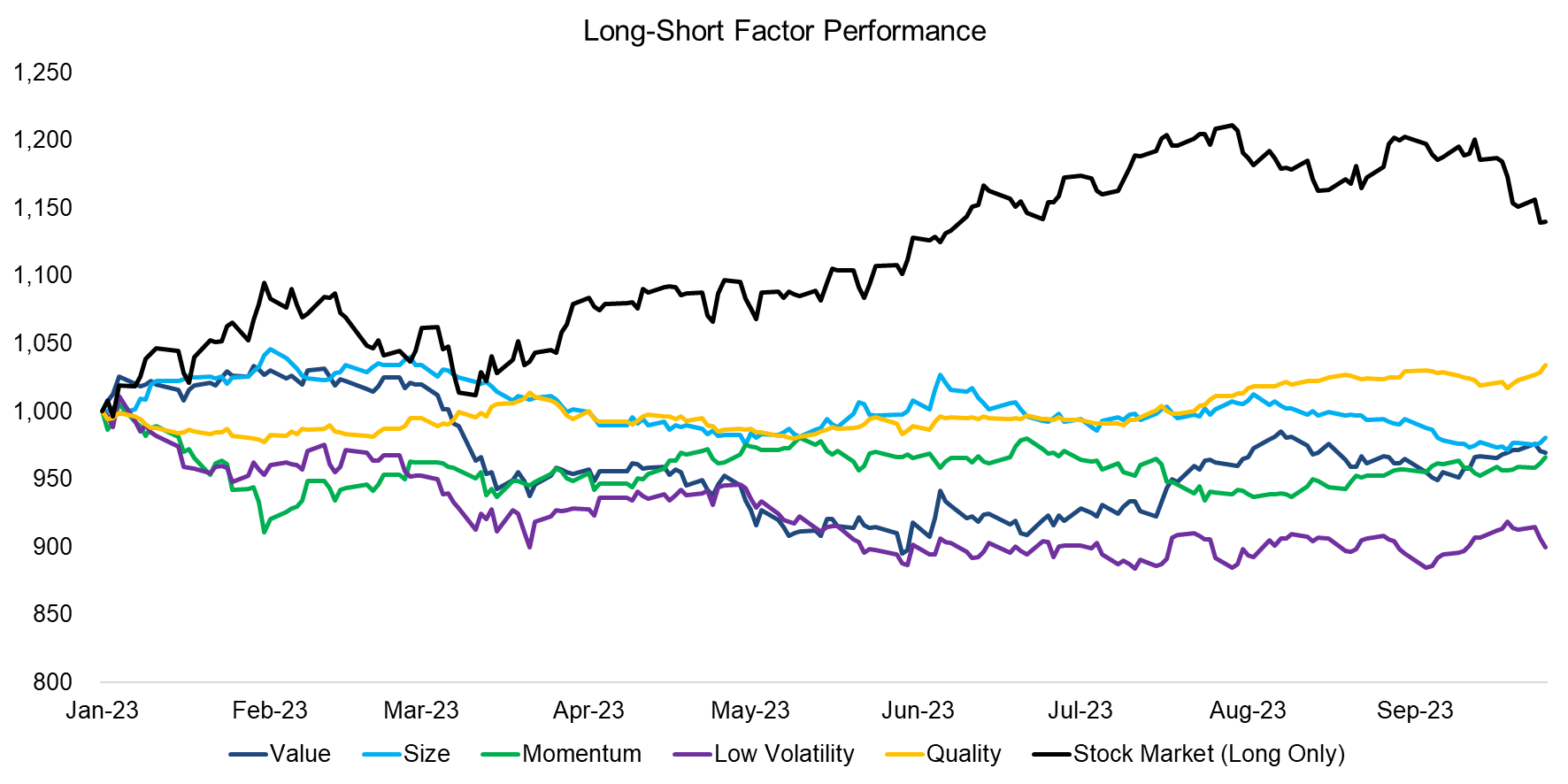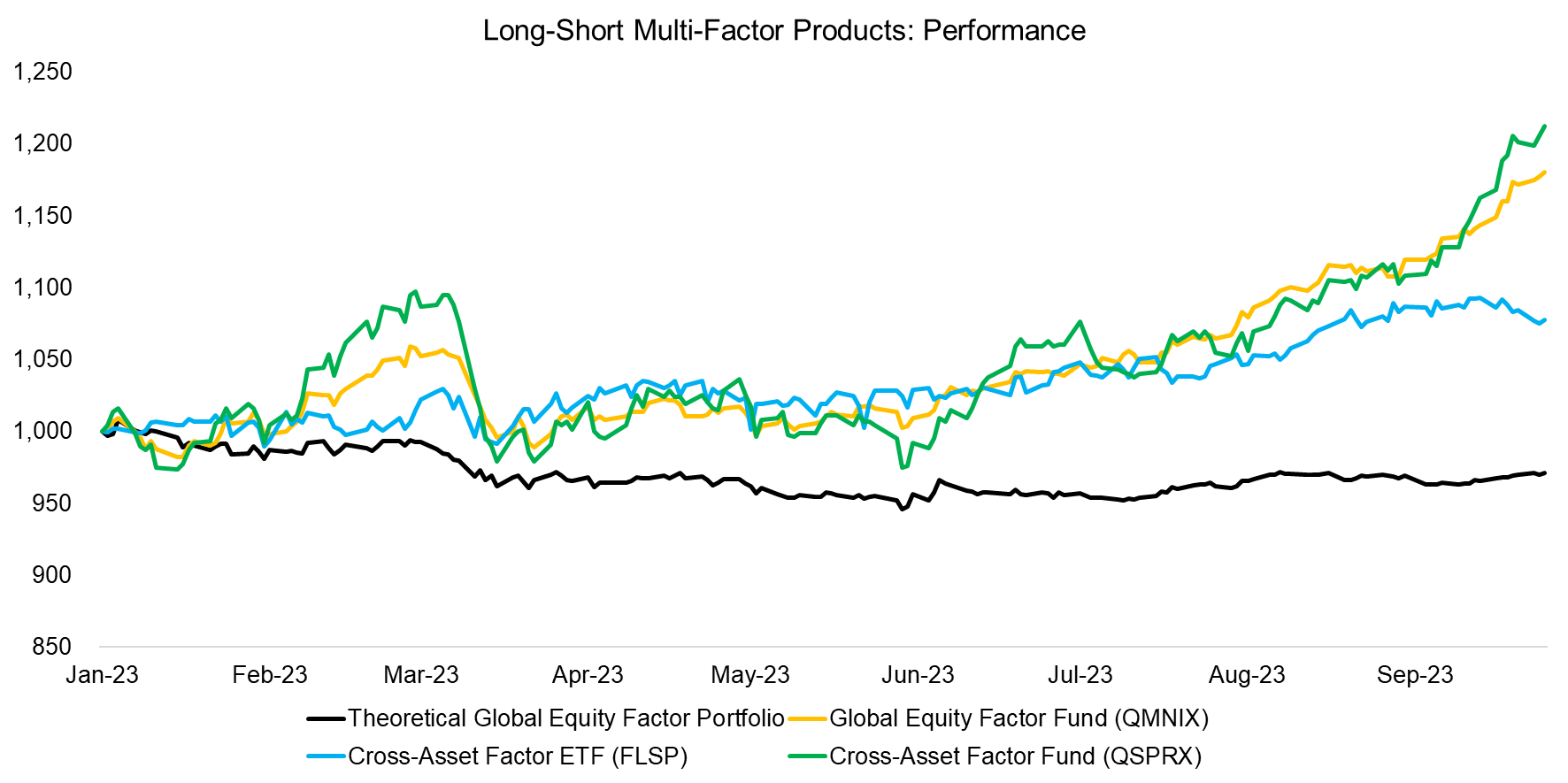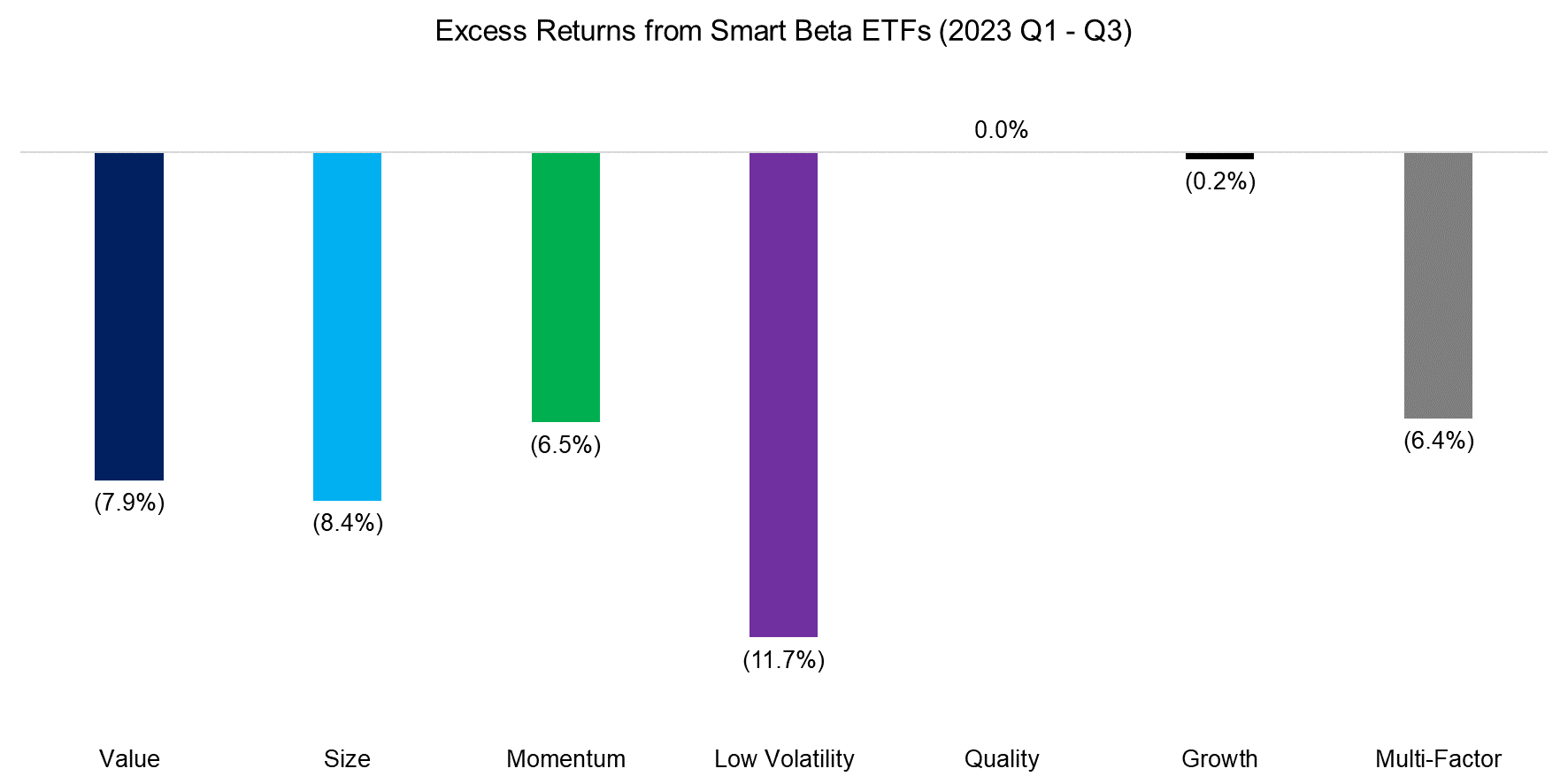Factor Olympics 2023 Q3
And the winner is…
October 2023. Reading Time: 10 Minutes. Author: Nicolas Rabener.
SUMMARY
- Most popular factors generated negative excess returns year-to-date
- Quality stocks performed best, low-risk stocks worst
- Somewhat surprisingly, long-short multi-factor products produced positive returns
INTRODUCTION
We present the performance of five well-known factors on an annual basis for the last 10 years. Specifically, we only present factors where academic research supports the existence of positive excess returns across market cycles and asset classes.
METHODOLOGY
Our factors are created by constructing long-short beta-neutral portfolios of the top and bottom 30% of stocks. Only stocks with a minimum market capitalization of $1 billion are included. Portfolios rebalance monthly and transactions incur 10 basis points of costs.
FACTOR OLYMPICS: GLOBAL RETURNS
The table below shows the long-short factor performance for the last 10 years ranked top to bottom. The global series is comprised of all developed markets in Asia, Europe, and the US. Aside from displaying the factor performance, the analysis highlights the significant factor rotation in terms of profitability from one year to the next, highlighting the benefits of diversified exposure.
After a great performance in 2022, almost all popular factors generated negative returns in year-to-date 2023. Only quality stocks, which are defined by a combination of return-on-equity and debt-over-equity, produced a positive return. Low-risk stocks performed worst with a wide margin to momentum and cheap stocks.

Source: Finominal
TRENDS IN GLOBAL FACTOR PERFORMANCE
The performance of factors in year-to-date 2023 has been relatively unexciting, except for the first quarter where momentum, low volatility, and quality factors seem to have been negatively correlated to the stock market. In contrast, value and size factors exhibited slightly positive correlations as they shared the same trends. It is worth noting that Finominal’s factors are constructed beta-neutral and rebalanced on a monthly basis, but they do occasionally pick up exposure to the stock market due to the beta-adjustment that uses a one-year lookback (read Beta in Beta-Neutral Factors?).
Post the first quarter, the volatility of factor returns decreased significantly, and most traded range-bound thereafter, except for quality stocks that outperformed in the third quarter of 2023.

Source: Finominal
PERFORMANCE OF LONG-SHORT MULTI-FACTOR PRODUCTS
There are only a few liquid alternative mutual funds and ETFs that provide exposure to factors in the long-short format as seen in academic research. Given the poor performance of factor investing in recent years, many products were liquidated.
Simplify Asset Management launched the Simplify Multi-QIS Alternative ETF (QIS) and Simplify Market Neutral Equity Long/Short ETF (EQLS), which provide exposure to risk premia and equity factors. However, these were launched in the third quarter of 2023, so their track record is too short to include them in this analysis.
We compare the performance of three surviving products to that of the theoretical equal-weighted multi-factor portfolio. Somewhat surprisingly, the three products have all generated positive returns in year-to-date 2023, compared to a slight loss for the theoretical performance. In previous years, the returns were more similar. Perhaps an indication of craftsmanship alpha?

Source: Finominal
SMART BETA EXCESS RETURNS
Although investors should allocate to factors constructed as long-short portfolios given that these offer high diversification benefits, most invest via long-only smart beta ETFs (read Smart Beta vs Alpha + Beta). Following the money, we highlight the excess returns generated from investing in smart beta ETFs in the US, which represents a universe of 160+ products and approximately $800 billion of assets under management. We also show the performance of the growth factor, which is popular with investors but is not associated with positive excess returns over time (read What Are Growth Stocks?).
The returns can be different as long-short factor portfolios are constructed beta-neutral, i.e. there is a short portfolio and leverage is used to achieve beta-neutrality, and stocks are typically weighted equally. Smart beta ETFs are long-only and mostly weight stocks by their market capitalization.
Although the magnitude of excess returns from smart beta ETFs was different from the long-short returns in year-to-date 2023, the direction was approximately the same. Quality stocks performed best, low-risk stocks worst.

Source: Finominal
FACTOR CORRELATIONS
The most interesting relationship is the high positive correlation between low-risk and cheap stocks, which is reminiscent of the tech bubble in 2000 that featured the same constellation. It is also interesting to note that there are no strongly negative correlations among factors currently (read Factors: Correlation Check).

Source: Finominal
FURTHER THOUGHTS
The dominant theme of 2023 is the performance of the Magnificent 7, namely Nvidia (NVDA), Meta Platforms (META), Amazon.com (AMZN), Microsoft (MSFT), Apple (AAPL), Alphabet (GOOGL), and Tesla (TSLA), as they have been contributing most of the positive return of the US stock market year-to-date.
These seven stocks, as well as others related to the enthusiasm for artificial intelligence (AI), are expensive, volatile, and feature large market capitalizations, which partially explains the poor performance of the value, low volatility, and size factors. They also are profitable and are not highly leveraged, which reconciles with the positive returns of the quality factor.
However, these stocks also have been outperforming, so why has the momentum factor performed poorly? The momentum factor has actually generated positive returns in the third quarter as more of these stocks have been selected for inclusion in the long portfolio, but this process takes time. Momentum is like a chameleon, it mimics the color of its environment but is not particularly fast-moving.
RELATED RESEARCH
Shorting Lousy Stocks = Lousy Returns?
Outperformance Ain’t Alpha
Improving the Odds of Value Investing
The Value Factor’s Pain: Are Intangibles to Blame?
Smart Beta vs Alpha + Beta
How Painful Can Factor Investing Get?
GARP Investing: Golden or Garbage? II
ABOUT THE AUTHOR
Nicolas Rabener is the CEO & Founder of Finominal, which empowers professional investors with data, technology, and research insights to improve their investment outcomes. Previously he created Jackdaw Capital, an award-winning quantitative hedge fund. Before that Nicolas worked at GIC and Citigroup in London and New York. Nicolas holds a Master of Finance from HHL Leipzig Graduate School of Management, is a CAIA charter holder, and enjoys endurance sports (Ironman & 100km Ultramarathon).
Connect with me on LinkedIn or X.

